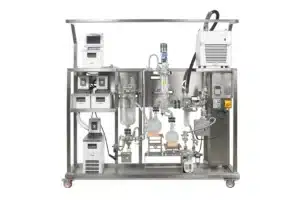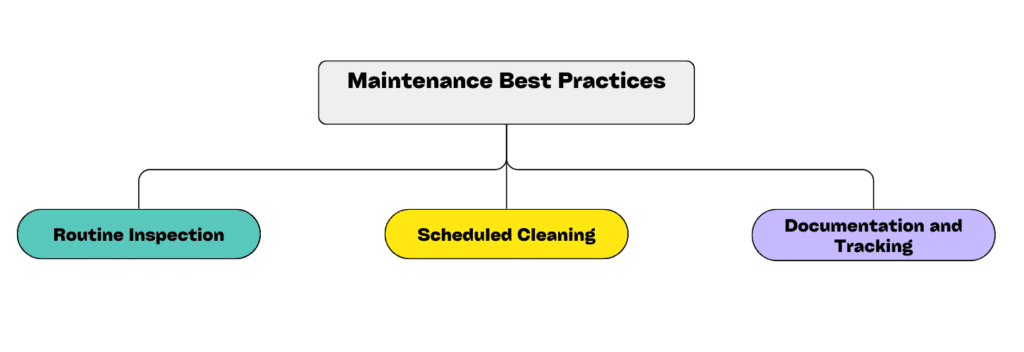Whether you are in the cannabis industry or pharmaceuticals, distillation equipment plays a crucial role in the production process. The efficiency and effectiveness of these systems are significantly affected by the cleaning and maintenance practices.
Regular upkeep of distillation equipment ensures optimal performance and directly impacts cost-efficiency, product yield, and overall safety. In this article, we explore cleaning routines and maintenance protocols that businesses can implement to extend the lifespan of their equipment, reduce downtime, and maintain the highest standards of product quality.
Sections
ToggleUnderstanding Distillation Equipment

Before exploring the cleaning process, we must know the industry’s most commonly used distillation equipment. Commonly used distillation equipment in the industry includes:
1. Short Path Distillation Equipment
 Used for thermal-sensitive compounds, short-path distillation is standard in science and research. Featuring a short distance between the evaporator and the condenser, such equipment allows distillation at a lower temperature by reducing the pressure. The main components of the short path distillation equipment include a heated evaporator, a short condenser, and a collection system.
Used for thermal-sensitive compounds, short-path distillation is standard in science and research. Featuring a short distance between the evaporator and the condenser, such equipment allows distillation at a lower temperature by reducing the pressure. The main components of the short path distillation equipment include a heated evaporator, a short condenser, and a collection system.
2. Rotary Evaporators

Commonly known as “rotovaps,” rotary evaporators are widely used in laboratories and small-scale production facilities. The apparatus comprises a rotating flask, a condenser, and a collection flask. By rotating the evaporation flask, you can increase the surface area for evaporation, enhancing efficiency.
3. Fractional Distillation Columns

The most complex of all types of distillation equipment, fractional distillation columns, are used for separating mixtures with components of similar boiling points. Fractional distillation columns have intricate designs with structures such as trays or packing materials that increase the contact between liquid and vapor phases, improving separation efficiency.
Find the Ideal Distillation Equipment for Your Business
Cleaning Challenges

Regardless of your distillation equipment, you must know some common cleaning challenges.
1. Residue Buildup
Like any other cleaning process, distillation produces residue, leading to a buildup. Over time, various types of residues can accumulate on the surfaces of the distillation apparatus. It includes organic compounds, inorganic salts, and polymeric materials. It is necessary to eliminate the residue buildup because it can significantly impact the efficiency of the distillation process by altering heat transfer rates, reducing the separation effectiveness, and potentially contaminating the final product.
Organic residues can polymerize or degrade over time, forming stubborn coatings that are difficult to remove. Similarly, inorganic salts can form scale deposits due to high heat exposure, reducing heat transfer efficiency.
Even small amounts of contamination can lead to off-specification products, reduced yields, and potentially compromise the integrity of the entire production.
2. Corrosion and Wear
Distillation equipment is susceptible to corrosion and wear due to exposure to aggressive chemicals or solvents, high temperatures, and pressure fluctuations. The materials used in distillation systems, such as stainless steel, glass, and various alloys, can corrode, leading to various problems, from minor surface pitting to catastrophic equipment failure.
If left unchecked, corrosion-related damage can result in costly repairs or replacement of equipment components, extended downtime, and potential contamination of products.
3. Time Constraints
In busy production environments, thoroughly cleaning and maintaining distillation equipment can be challenging. Cleaning cycles can disrupt production, which can affect revenue. However, shortened cleaning cycles or postponed maintenance activities can lead to more significant problems.
To address this challenge, consider the following strategies:
- Implement a scheduled maintenance program: A comprehensive plan that allows specific time for cleaning and maintenance activities can help ensure that maintenance is not overlooked amidst busy production schedules.
- Use quick-connect systems: Investing in equipment designs that allow for rapid disassembly and reassembly is recommended. It reduces the time required for cleaning operations.
- Train multiple team members: Training a team of staff members in cleaning and maintenance procedures will allow for greater flexibility. It will enable better scheduling by reducing dependence on specific individuals.
- Conduct preventive maintenance: Regular, proactive maintenance of the distillation equipment can prevent more significant issues requiring more extensive downtime.
These are some common strategies companies can use to maintain the cleanliness and efficiency of their distillation equipment without significantly disrupting their production workflow.
Cleaning Solutions for Different Types of Distillation Equipment

Let’s take a comprehensive look at cleaning solutions for distillation equipment, depending on their type.
1. Short Path Distillation Equipment
Step-by-step cleaning process:
- First, carefully disassemble the equipment.
- Remove any visible residues using soft brushes or sponges.
- Prepare a cleaning solution appropriate for the type of residue. A mild detergent solution is suitable for organic reduction, while dilute acid can clean the inorganic scale.
- Soak the components in the cleaning solution.
- Scrub gently to remove stubborn residues.
- Rinse the components thoroughly with distilled water.
- After the rinse, dry using clean, lint-free cloths or filtered compressed air.
- Reassemble the equipment, checking all seals and connections.
Tools and cleaning agents:
- Mild, non-abrasive detergents for general cleaning
- Dilute acids (e.g., citric acid) for scale removal
- Use specialized solvents for stubborn organic residues
- Non-abrasive sponges
- Lint-free clothes for drying
- Ultrasonic cleaners for small, intricate parts
Tips for ensuring thorough cleaning and preventing cross-contamination:
- Do not use the same cleaning tools for different product lines to prevent cross-contamination.
- A color-coding system for cleaning tools and solutions will help maintain consistency.
- Use analytical techniques to validate the cleaning process.
For more details on the Short Path Distillation process, check out this comprehensive guide.
2. Rotary Evaporators
Step-by-step guide:
- Disassemble the rotary evaporator, separating all glassware components.
- Rinse glassware in appropriate solvents to remove most residues.
- Prepare a cleaning solution suitable for the type of residue.
- Use gentle agitation if necessary to break down stubborn buildup.
- Use specialized brushes to clean narrow necks and joints.
- Rinse thoroughly with distilled water.
- For cleaning seals and O-rings, use a mild detergent solution to avoid degrading the material.
- Inspect seals for wear or damage and replace them if necessary.
- Dry all components thoroughly before reassembly.
Importance of checking for wear and tear:
- Regularly inspect glassware for chips, cracks, or scratches
- Check ground glass joints for proper fit.
- Examine seals and O-rings for signs of degradation, such as hardening or cracking.
- Inspect the rotary drive mechanism and bearings for smooth operation.
Best practices for maintaining vacuum integrity:
- Clean and lubricate vacuum seals with appropriate vacuum grease.
- Check and clean the vacuum port regularly to ensure unobstructed flow.
- Always use a vacuum gauge to monitor system performance.
- Perform regular leak tests.
3. Fractional Distillation Columns
Step-by-step guide:
- Drain the column and flush with an appropriate solvent to remove loose residues.
- Gently circulate the cleaning solution through the column, ensuring complete contact with all internal surfaces.
- If the system has packed columns, consider removing and cleaning the packing material if it is heavily fouled.
- Use specialized cleaning tools, such as column brushes or high-pressure sprayers, to clean internal structures.
- Rinse thoroughly with distilled water or a suitable solvent.
- Dry the column using warm, filtered air or an inert gas purge.
Importance of checking for blockages and residue:
- In fractional distillation, blockages and residue building can result in inefficiency. Regularly inspect column internals for signs of residue buildup.
- Check for uniform distribution of liquid across trays or packing.
- Keep an eye on pressure drop as it can indicate potential blockages.
- Use borescopes or other inspection tools to examine hard-to-reach areas of the column.
Recommended cleaning solutions specific to column materials:
- For stainless steel columns, use mild alkaline or acidic cleaners.
- Glass columns may require gentler cleaning agents to avoid etching or damage.
- Distillation columns with specialized coatings or linings come with manufacturer recommendations for compatible cleaning solutions.
- Use enzymatic cleaners for biological or protein-based residues.
Maintenance Best Practices

Here are the best practices recommended for maintaining an efficient maintenance schedule-
1. Routine Inspection
Regular inspections help proactively identify potential issues before they escalate into major problems. Monitor all components for signs of wear, corrosion, or damage. Track key performance indicators such as heat transfer efficiency, separation quality, and energy consumption to identify deviations from regular operation.
2. Scheduled Cleaning
A structured cleaning schedule helps maintain equipment performance and prevents the buildup of contaminants. A comprehensive cleaning schedule should have appropriate cleaning intervals based on production volume, types of materials processed, and equipment specifications. An optimized schedule of cleaning alternates between thorough, deep cleaning sessions and more frequent, quick cleaning procedures.
3. Documentation and Tracking
Maintaining detailed records of cleaning and maintenance activities- Maintenance logs ensure consistency and traceability in the cleaning process. Develop and use standardized checklists for each type of equipment to ensure all necessary steps are completed. We recommend implementing computerized maintenance management systems (CMMS) for more efficient tracking and scheduling of maintenance activities.
Benefits of Regular Cleaning and Maintenance
Regular cleaning not only maintains the efficiency but also offers several other benefits:
- Enhanced Product Quality
Regular cleaning and maintenance of distillation equipment minimize the risk of cross-contamination between batches and products. It directly enhances the product quality and maintains the high purity levels required in many industries, such as pharmaceuticals and fine chemicals.
- Operational Efficiency
Proper maintenance practices significantly enhance the operational efficiency of distillation processes. When there is no residue buildup to insulate, heat efficiently transfers through surfaces, reducing energy consumption. It also prevents unexpected breakdowns, minimizing costly production interruptions.
- Extended Equipment Lifespan
Regular cleaning and maintenance can substantially extend the lifespan of distillation equipment. It prevents corrosion, and routine inspections allow for the early identification and resolution of potential issues before they cause significant damage.
Conclusion
In any industry using distillation equipment, the cleaning and maintenance of such equipment is mandatory for ensuring efficient, safe, and cost-effective operations. Companies can significantly enhance their operational performance by understanding the unique challenges of different distillation equipment types and implementing comprehensive cleaning and maintenance strategies.




